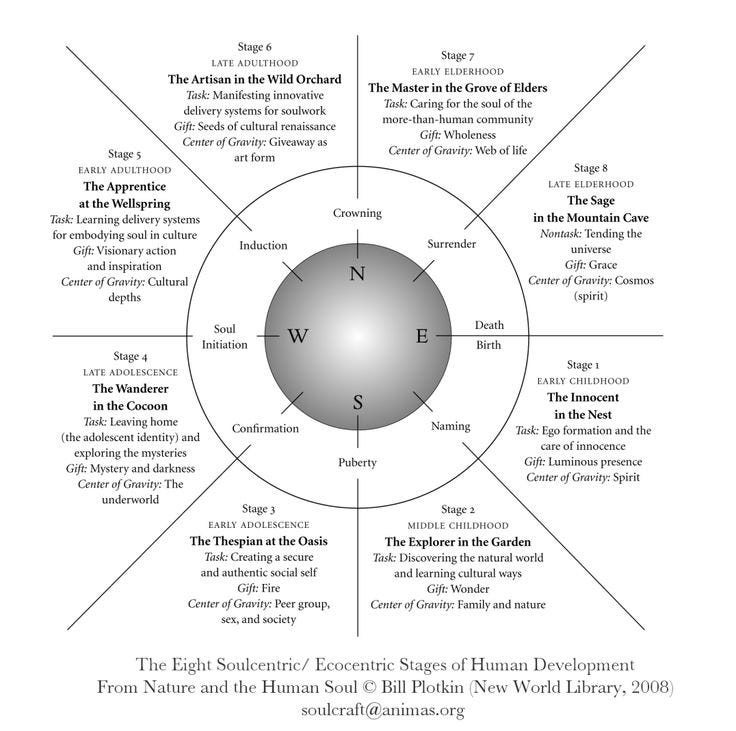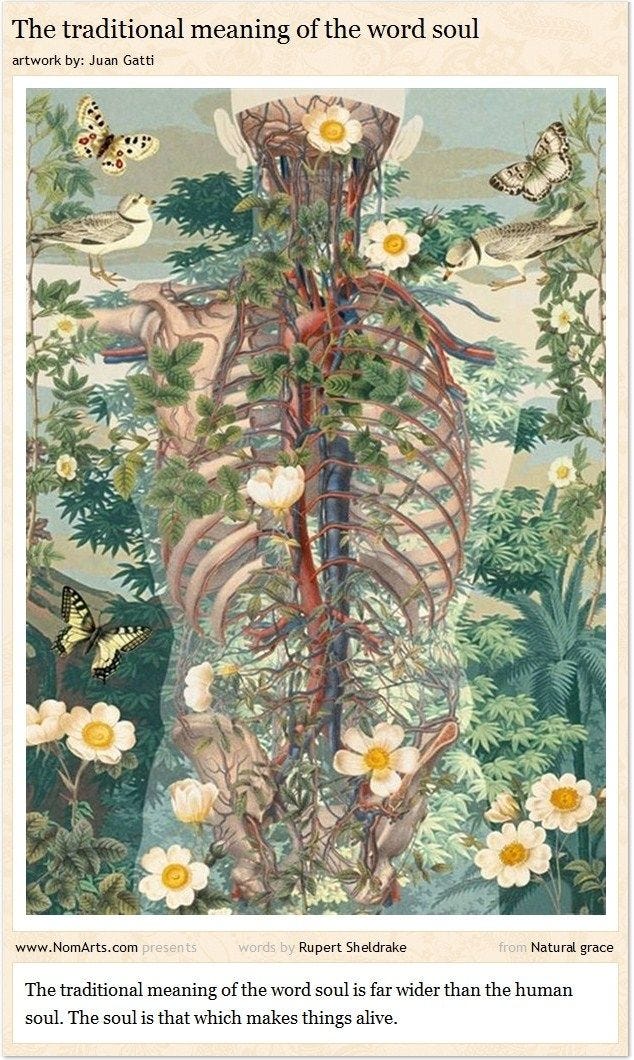Stage 3: Emergence & the Regenerative Springboard
Completing the Journey Through Stage 3 & Beyond the Adolescent Civilization
What if many of our social and environmental challenges stem from collective arrested development at the adolescent stage? What if many of us, despite our chronological age, are still working through the psychological tasks of our teenage years?
In a world facing ecological collapse and deepening social divides, these aren't just theoretical questions, they matter deeply. Our inability to address climate change, restore watersheds, and rebuild community may be directly connected to our psychological development. The path toward bioregional regeneration requires more than new technologies or policies— it requires us to complete our journey to psychological adulthood in parallel.
For the past several years, I've been exploring practice through Bill Plotkin's developmental wheel model, particularly Stage 3 (Early Adolescence). This exploration has become central to my work. Excitedly, I head to Kentucky in a few short weeks to visit the Buck Creek community, escape the searing desert heat, meet the land of the interior plateau & southern great lakes forest & mid-western tall grass prairie & forest transition (Louisville, KY, Detroit, MI, Kansas City, MO, Madison, WI), and demo this new workshop of Stage 3 practices.

Regenerating Earth: Why All We Have is Now
The 2025 cohort of the 6-month learning journey 'How to Organize Your Bioregion' led by Joe Brewer and Penny Heiple at 'The Design School for Regenerating Earth' began this week. This work is a fractal of what I wrote about in my last essay which in many ways is about regeneration.
You can read it here:
I’ve followed the ecological science for over a decade now. The journey of understanding how Earth has been changed due to human impacts came into clear view while getting a degree in Solar and Wind Technology in 2014. During the winter semester of that year, I served as an intern for Al Gore’s ‘Massachusetts Clean Energy Center.’ We had crossed 3 of the 9 thresholds then. Today we’ve crossed 6.
What I know is that we’ve crossed too many planetary boundaries which will undoubtably lead to widespread civilization collapse. The 5 breadbaskets of the world supply the majority of food to the planet and with unstable climate conditions and extreme weather events becoming more and more common the possibility for these food production areas to be impacted increases greatly. If 2 of these 5 breadbaskets went down at the same time, within a few months 2 billion people will starve to death. Just one fun fact about what’s to come. Do you know where your food comes from and what you’d do if it wasn’t there for you?

See the data from the Stockholm Resilience Center.
A recent study shows 99% of private wealth is owned by 8 white men. “The global economy isn’t broken, it’s fixed.” Joe Brewer.
99% of our ancestors lived sustainably, in harmony with their environment. It’s only been over the last 12,000 years, during this Holocene Period of unprecedented climate stability that we’ve created city states and civilizations that are not sustainable. While there are many “black swans” there are many positive social tipping points as well or “green swans.”
You and I are made of Earth, the crust, the water, the dust. We are animated Earth. And more and more are waking up to this reality. My work is in building interior readiness for the messiness of this unlearning journey. My inquiry focuses on designing a comprehensive Stage 3 springboard for ecocentric communities.
I’ll serialize my learning here hoping for your collaborative feedback, encouragement and challenge.
Learn more about the Design School here.
The Adolescent Stage We Never Fully Completed
In Plotkin's developmental model, Stage 3 (early adolescence, ages 12-17) represents a critical formative period with six key developmental tasks:
Establishing ego identity - discovering who we are separate from family
Developing social intelligence - navigating peer relationships and group dynamics
Cultivating emotional literacy - recognizing and regulating increasingly complex feelings
Exploring romantic/sexual identity - understanding boundaries and attractions
Questioning authority - developing critical thinking about social structures
Building interiority - creating a rich inner life through self-reflection
Plotkin argues that modern society remains collectively stuck at this stage due to systemic factors: the absence of true elders, consumer capitalism prioritizing adolescent desires, educational systems that discourage critical thinking, our cultural denial of death, the fragmentation of community bonds, media that targets our most adolescent impulses, and perhaps most critically, our disconnection from the natural world and meaningful rites of passage. These conditions create a “patho-adolescent” culture where completion of Stage 3 becomes increasingly difficult, preventing both individual maturation and the cultural wisdom necessary for ecological renewal and human survival. We're in the midst of the fastest mass extinction event in Earth's history, and the developmental bottleneck we need to pass through is clogged. Culturally, we’re stuck in Stage 3.
When Stage 3 Patterns Show Up in Adult Life
A few months ago, I wrote about a hitchhiking trip I took in 2016. After publishing, I experienced a huge contraction. Fear and insecurity overtook me. I was overwhelmed by protective shame. In NARM (NeuroAffective Relational Model), we recognize shame as protection. Culturally, we shame ourselves often without realizing it, even as adults.
One of my most engaged subscribers unsubscribed, and “boom”— the rumination began. "Oh, no. What did I do?"
My work over the following weeks involved exploring this fear. After many days of dedicated inquiry and speaking to the land—"poof”—the spell lifted. A somatic shift opened up an effervescent full torso blast of energy— a lot but not too much. I directed my attention toward the mitochondria and settled into the rhythmic pulse of cellular expansion, matching them with breath. Synching up in rhythmic attunement helped create a dance-like collaboration between mind and body. At this time I was learning about “the cell danger response.” I remembered Dr. Joe Dispenza’s book “You are the Placebo: Making Mind Matter.” I was integrating both top down and bottom up.
This pattern— concern with others' approval, fear of rejection, self-shaming—is classic Stage 3 territory. Even as adults facilitating developmental work, we revisit these patterns. The difference comes in how we move through them. I have a desire to be more transparent about these processes as a way of normalizing this taboo that continues to be repressed, suppressed and denied. It's keeping us stuck culturally ill and awareness followed by acknowledgment are the first steps to shifting these patterns.
A Community Exploring Stage 3 Together
In mid-February, I attended a relational practice immersion— a weekend retreat I organized for 25 people from our Santa Cruz watershed community. While not explicitly framed as developmental work, we were collectively exploring several Stage 3 tasks: developing social intelligence, cultivating emotional literacy, and building that sense of 'interiority.’
The retreat proved successful in many ways, and as is often the case with these types of events, I also noticed classic Stage 3 patterns emerging, some inside myself and others: cliquishness reflecting incomplete ego identity formation, concern with “doing it right” showing the social approval-seeking characteristic of adolescent development, and deference to perceived authority figures that may reveal incomplete questioning of social structures. For myself, I experienced tension around safety in the larger container— an example of the boundary negotiation central to Stage 3 work which I’ve been researching and will explore in future essays “on safety and fun.”
These moments revealed how even in communities dedicated to relational and personal growth practices, our developmental gaps persist. The beauty came in witnessing these patterns together, creating the possibility for collective movement toward the more mature stages of development our bioregional work demands.
Exploring Your Own Stage 3 Patterns: A Simple Exercise
(I’ve posted my answers in the comments)
Take 5-10 minutes to reflect on these questions, writing or speaking your responses:
When do you find yourself most concerned with others' approval? Notice the sensations in your body as you consider this.
What "groups" do you still feel a need to belong to? What would happen if you didn't?
Think of a time you expressed an authentic part of yourself and felt criticized. How did you respond? What would responding from adult wholeness look like?
Let your reflections be curious rather than judgmental. I’ve used the questions to shame myself. These patterns are cultural as much as personal. Be gentle with yourself, and honest.

Why This Development Matters for Earth Regeneration
Moving beyond Stage 3 isn't just about individual personal growth— it's essential for our collective capacity to address the complex challenges we face.
Stage 3 thinking creates specific limitations in bioregional work:
Short-term focus: Adolescent psychology prioritizes immediate gratification over the multi-generational thinking needed for ecological restoration and species survival
Approval-seeking: When we're caught in Stage 3 patterns, we make decisions based on social acceptance rather than ecological necessity
Binary thinking: Complex systems require nuanced understanding, while adolescent thinking tends toward black-and-white judgments
Identity-based divisions: Watershed healing requires collaboration across differences, but Stage 3 patterns reinforce tribal affiliations and us-versus-them mentalities
The mature adult stages that follow bring essential capacities:
Systems thinking that perceives interconnections across ecological and social dimensions
Comfort with uncertainty and paradox
The ability to act from genuine service rather than approval-seeking or material gain
Capacity to hold multiple perspectives simultaneously
Patience for slow, generational change processes
This developmental progression directly impacts our effectiveness as cultural regenerators. Consider how often our efforts fail due to social dynamics, ego conflicts, and inability to collaborate across differences— all hallmarks of arrested Stage 3 development. We cannot create healthy ecological systems from adolescent psychological patterns, regardless of our technical knowledge or good intentions.
Emergence Through Collapse: A Developmental Perspective
As we face the reality of crossed planetary boundaries and impending civilizational challenges, a synthesis emerges between collapse dynamics, emergence theory, and developmental psychology:
The Developmental Imperative
Our collective arrested development at Stage 3 adolescence directly impedes our capacity to navigate ecological collapse. The adolescent patterns that persist in our societies— short-term thinking, approval-seeking, binary judgments, and tribal affiliations— render us ill-equipped to face extinction-level threats. Like teenagers with nuclear codes and now AI, we possess technological power without the psychological maturity to wield it wisely.
Collapse as Developmental Catalyst
What if collapse itself serves as the transformative pressure needed to complete our collective adolescence? When existing systems falter, several emergent opportunities arise:
Dissolution of outdated identities: As global supply chains and institutions break down, our attachments to consumer identities and status hierarchies necessarily loosen
Localization fosters maturity: Bioregional organization requires us to develop adult capacities— systems thinking, comfort with uncertainty, and multi-generational visions
Necessity drives developmental leaps: Crisis conditions create natural selection pressures favoring those who can transcend adolescent patterns
Self-Organization at the Edge
At the boundary between order and chaos— precisely where collapse places us— emergence flourishes. The most promising responses already visible in our watersheds share key characteristics:
They operate through simple, adaptable rules rather than rigid centralized control
They balance individual autonomy with collective intelligence
They emerge organically from local conditions rather than being arbitrarily imposed from above
Beyond Prediction to Participation
Both collapse and emergence resist prediction by their very nature. Rather than attempting to forecast exactly how these processes will unfold, our task becomes one of active participation in creating conditions where beneficial emergence can occur. This requires:
Cultivating personal and collective practices that support developmental completion
Building “pockets of emergence/ islands of sanity” through bioregional organization
Allowing chaos to serve its evolutionary function without premature attempts at control
As Stuart Kauffman noted, emergence represents “order for free”— a natural product of systems navigating complexity. Our survival through this great mas extinction depends on fostering the conditions where mature, regenerative patterns can spontaneously emerge from collapse processes.
The developmental journey and the ecological journey are one and the same. To regenerate Earth, we must complete our adolescence— not despite collapse, but through it. Think caterpillar to butterfly— we must enter the cocoon and do the most difficult thing— die to be reborn.

Continuing the Journey Together
This introduction to Stage 3 development begins a journey we'll take together. Next month, I'll share specific practices for identifying and moving beyond adolescent patterns, followed by an exploration of how watershed consciousness emerges from mature development.
Three immediate ways to engage with this work:
Join our monthly developmental practice circle for paid subscribers starting soon, where we'll explore these patterns in community as well as the nervous system calibration tools necessary to undertake this work
Try the self-reflective exercise above, then share one insight in the comments - your experience helps others recognize their own patterns
Bring this lens to your local neighborhood group - notice how Stage 3 patterns might be affecting collaboration and decision-making
Like water finding its way downhill, our development seeks completion when given the right conditions. By creating those conditions together— through relational practices, ecological connection, and honest self-reflection— we're cultivating the mature culture our neighborhoods desperately need.
For bioregional organizers interested in bringing this developmental framework to your community, I'll be offering workshops based on learnings from the Kentucky training this summer.
Email to connect~
If you’re feeling a sense of resonance or alignment and want to help me carry out this mission, consider becoming a paid subscriber to support my work and join a community of practice.
The Design School is still accepting students for this years cohort, thru April. It’s only $5/mo. If you’re interested in cultivating ecocentric community and organizing your bioregion as a way of regenerating Earth, check it out. It will be great to see you there!
With Love,
Patrick
References
Brewer, J. (2023). The design school for regenerating Earth. Earth Regenerators Network.
Holling, C. S. (2001). Understanding the complexity of economic, ecological, and social systems. Ecosystems, 4(5), 390-405. https://doi.org/10.1007/s10021-001-0101-5
Kauffman, S. A. (1995). At home in the universe: The search for the laws of self-organization and complexity. Oxford University Press.
Plotkin, B. (2008). Nature and the human soul: Cultivating wholeness and community in a fragmented world. New World Library.
Rockström, J., Steffen, W., Noone, K., Persson, Å., Chapin, F. S., Lambin, E. F., Lenton, T. M., Scheffer, M., Folke, C., Schellnhuber, H. J., Nykvist, B., de Wit, C. A., Hughes, T., van der Leeuw, S., Rodhe, H., Sörlin, S., Snyder, P. K., Costanza, R., Svedin, U., ... Foley, J. A. (2009). A safe operating space for humanity. Nature, 461(7263), 472-475. https://doi.org/10.1038/461472a
Stockholm Resilience Centre. (2023). Planetary boundaries. https://www.stockholmresilience.org/research/planetary-boundaries.html
Steffen, W., Richardson, K., Rockström, J., Cornell, S. E., Fetzer, I., Bennett, E. M., Biggs, R., Carpenter, S. R., de Vries, W., de Wit, C. A., Folke, C., Gerten, D., Heinke, J., Mace, G. M., Persson, L. M., Ramanathan, V., Reyers, B., & Sörlin, S. (2015). Planetary boundaries: Guiding human development on a changing planet. Science, 347(6223), 1259855. https://doi.org/10.1126/science.1259855
Walker, B., & Salt, D. (2012). Resilience thinking: Sustaining ecosystems and people in a changing world. Island Press.



